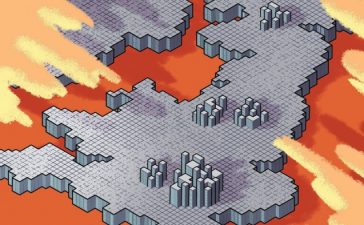Around 700 million years ago, the Earth was one massive snowball – but scientists had no idea why.
The ice age, also known as the Sturtian glaciation, lasted from 717 to 660 million years ago, well before the dinosaurs or complex plant life existed on our little blue marble.
From pole to pole, the planet was covered in snow and ice.
Now, Australian geologists have figured out what caused the extreme ice-age climate – and it’s all due to carbon dioxide (CO2).
Yes, that same CO2 that’s causing global warming today because we have too much of it once had the exact opposite effect, with chilling consequences.
The team has revealed the ice age began roughly when there was an all-time low in volcanic CO2 emissions – and these emissions remained low for the entire duration of the freeze.
‘We now think we have cracked the mystery,’ said lead author Dr Adriana Dutkiewicz. ‘Historically low volcanic carbon dioxide emissions – aided by weathering of a large pile of volcanic rocks in what is now Canada, a process that absorbs atmospheric carbon dioxide,’
Carbon dioxide is a greenhouse gas and is vital in moderation.
As sunlight comes into the atmosphere, and bounces off the surface of the Earth, greenhouse gases like CO2 absorb and re-emit that radiation – so the heat holds.
Less CO2 means less heat, which will result in the Earth’s temperature plummeting.
‘Various causes have been proposed for the trigger and the end of this extreme ice age, but the most mysterious aspect is why it lasted for 57 million years – a time span hard for us humans to imagine,’ said Dr Dutkiewicz.
The team used the University of Sydney EarthByte computer models to look at what caused this mammoth ice age.
Sturtian glaciation: the lowdown
- The world-wide freeze took place during the Cryogenian Period – which lasted from 720 to 635 million years ago
- It is hypothesised to be a Snowball Earth event, freezing the world from the poles to the equator
- Rocks in every continent have evidence for the Sturtian Glaciation
- The name hails from British explorer Charles Sturt, after a rock formation in the Sturt River gave its name to the glaciation
A plate tectonic model revealed the evolution of continents and ocean basins after the breakup of another supercontinent, Rodina.
From there, the team connected it to a computer model that calculated CO2 release from underwater volcanoes along mid-ocean ridges – where plates separate and new ocean crust is created.
‘At this time, there were no multicellular animals or land plants on Earth,’ said Dr Dutkiewicz. ‘The greenhouse gas concentration of the atmosphere was almost entirely dictated by CO2 out-gassing from volcanoes and by silicate rock weathering processes, which consume CO2.’
Co-author Professor Dietmar Müller, from the University of Sydney, said: ‘Geology ruled climate at this time. We think the Sturtian ice age kicked in due to a double whammy – a plate tectonic reorganisation brought volcanic degassing to a minimum, while simultaneously a continental volcanic province in Canada started eroding, consuming atmospheric CO2.
‘The result was that atmospheric CO2 fell to a level where glaciation kicks in – which we estimate to be below 200 parts per million, less than half today’s level.’
Today, even though volcanic activity is low, human-induced carbon emissions are causing the planet to heat up.
The study was published in Geology.
MORE : London ‘underprepared’ for deadly climate change, experts warn
MORE : Project Iceworm and the labyrinth of tunnels dubbed ‘the safest place on Earth’
MORE : UFO hunter spots ‘elf’ at the South Pole on Google Earth
Get your need-to-know
latest news, feel-good stories, analysis and more
This site is protected by reCAPTCHA and the Google Privacy Policy and Terms of Service apply.














